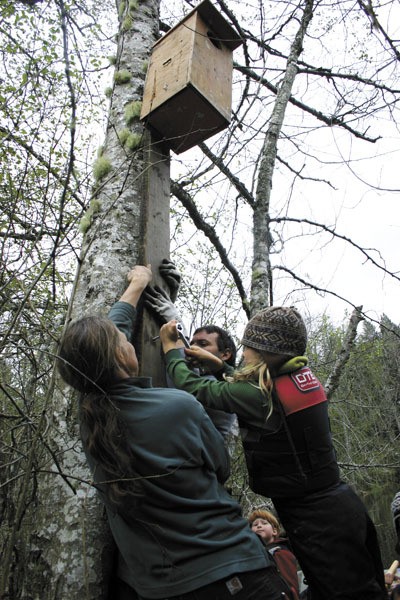Each of the 12 children at Homestead Farm and Wilderness Learning Community has a special duck name, something the kids took on as they began a course of study about the natural history of Island ducks earlier this year.
Tayo Jamison’s species of choice is the ring-necked duck. Quinn Williams is the green-winged teal. B Timken adopted the common goldeneye.
Now, these young birders have something else to add to their list: They’ve embarked on an ambitious effort to help bring a population of wood ducks — colorful, elusive birds that require large nesting cavities for their broods — to Meadowlake Pond in Island Center Forest.
For the past few weeks, the kids, ages 6 to 9, have studied the bird and its nesting needs, learning along the way that an absence of large holes in snags has had an impact on its population, said Dana Schuerholz, Homestead’s founder and one of its teachers. But they also learned that people can help: When nesting boxes are put up around ponds and lakes in regions where they live, research shows, the birds often claim the new-found habitat, and their numbers climb.
So last week, on a cool and breezy Earth Day, the kids and their teachers from this home-school enrichment program brought their project to fruition. They ventured out onto the nearly inaccessible pond in two rowboats laden with nesting boxes, tools, plenty of rice cakes and hip-waders — in search of trees to host the boxes they’d built themselves from salvaged wood.
It wasn’t easy.
One of the trees they chose was an alder on the edge of a small island, surrounded by partly submerged willows — a tangled, mucky shoreline that made it near-impossible to get out of the boats and onto land. So for nearly 45 minutes, some kids helped while others watched as Schuerholz, her daughter Djuna Schuerholz-Wright and Joe VanHollebeke, a resource coordinator with King County’s Department of Natural Resources and Parks, stood at the bow of the boats, hefting the large box into place. Another child, Brian DeLoach, held the boats steady.
They hammered, drilled and used wrenches to attach the nest box to the tree. After it was installed, they realized they’d forgotten to line the box with wood shavings, something the wood duck needs. So Djuna, a nimble 8-year-old, shimmied up the tree, opened the box and dumped in a pile of wood shavings, spilling a portion of them onto her mother below.
Schuerholz, dusted with shavings, gave a wry smile. “Usually it goes easier than this,” she said.
Even so, she, VanHollebeke and the kids were happy with the results. By day’s end, three of the four boxes they’d built were attached to trees — all of them high enough, they hoped, to keep nesting birds safe from raccoons, one of their predators.
Asked how she felt about the expedition, Djuna answered matter of factly, “It was fun. I liked helping ducks.”
VanHollebeke, a former fifth-grade teacher, said he was impressed by the kids.
“They’re ready to go, not afraid and good listeners,” he said. “And I can’t believe how they all can handle tools.”
Island Center Forest, a 363-acre expanse of woods and trails, is owned by King County, which has experienced considerable budget cuts over the last couple of years. VanHollebeke said stewards like those from Homestead are making a difference.
“They’re helping us to do what we don’t have the manpower to do,” he said.
Schuerholz said she and her partner Sarah Wright, co-founder of the school, decided to take on the wood duck project in part because of their deep belief that children need to be connected to the natural areas that surround them. Such a connection not only grounds them to a place, she said, but also helps them to connect to a larger conservation movement — one that, in this case, has helped the wood duck come back from perilously low numbers a century ago, when it was aggressively hunted.
“It’s a miraculous conservation story,” Schuerholz said.
In the course of building the wood boxes, the kids learned the story of wood duck conservation, including the fact that hunting organizations are now some of the leaders in habitat protection for the colorful bird.
“The story of the wood duck is a story of how people with the right information changed and shifted their ways,” she said.
But Schuerholz said last week’s outing was not a one-time affair for the school. The school’s students will monitor the boxes — not just this season but for years to come — watching for wood ducks or other birds that might inhabit them and cleaning the boxes out once a brood has fledged.
Such maintenance, she said, might enable a duck pair to hatch a second brood. It will also keep the school and its students deeply connected to Meadowlake Pond for a long time.
Rowing the kids out to the island as she talked, Schuerholz glanced around at the pond, ringed by willows, alders and firs. A pair of buffleheads landed nearby, drawing an exclamation from the kids. Woodpeckers could be heard in the distance. Yellow-rumped warblers darted among the trees.
“This is just the beginning of a long-term relationship with this pond,” Schuerholz said. “That, to me, is the really exciting piece.”
For more information about Homestead Farm and Wilderness Learning Community, visit its Web site at homesteadschool.org or call 463-0822.



